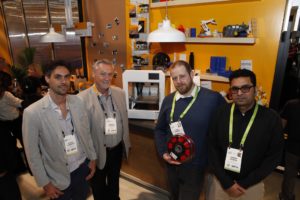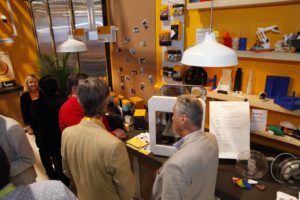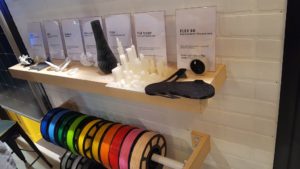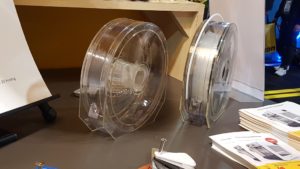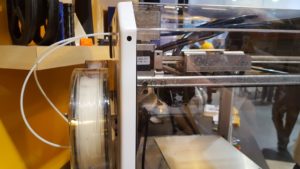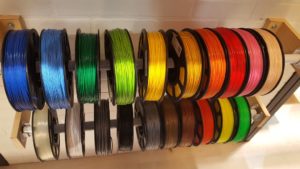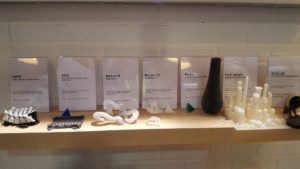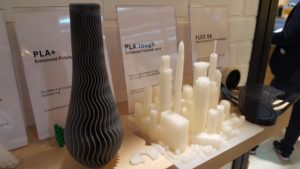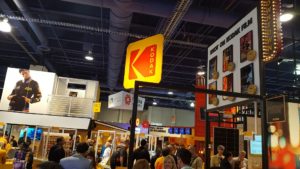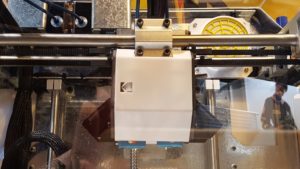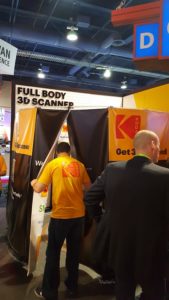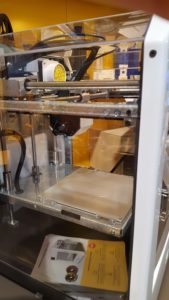
We’ve been looking forward to seeing the Portrait 3D printer in person for the first time, and on the first full day of CES I had the opportunity to sit down with Demian Gawianski, the COO of Kodak 3D Printing, to learn more about the portfolio. The 3D printer was developed through a global brand licensing agreement, as Argentina-based Smart International has been developing and manufacturing 3D printers for the last six years. About a year and a half ago, Gawianski explained, the company began on the journey that would lead to a new professional 3D printing solution for the market.
“We developed a 3D printing solution for the professional market, which is different to what we’ve been doing before that,” he told me. “We had a very good initial connection with Kodak, and they determined that we were the best solution for the market they target.”
For its part, globally-known Kodak had had its eye on an entrance to the 3D printing market for a few years, as the company’s CMO set the technology as a strategic priority about three years ago. Kodak is a long-established brand for creative professionals who, as Gawianski put it, are “people who make things that endure, things made in the past that stay for the future,” and the 130-year-old company was determined to step forward into a new technology only upon finding a high-quality solution that would meet the needs and expectations of its customers, along with stellar customer support.
In developing offerings geared toward professionals, certain requirements arise: reliability, repeatability, and accuracy are chief concerns. For the Portrait 3D printer and its ecosystem, Kodak is looking mainly to the same target as overall company customers: engineers in product development, designers, architects, medical users, and educational users, as well as for applications in prototyping across verticals. A full ecosystem approach ensures end-to-end attention to detail in each area, as a 3D printer, materials, and software must work together for best results.
- Gawianski (L) and the team with the Portrait 3D printer
- Crowds at CES examine the new 3D printing ecosystem [Photos: Kodak]
“They said we asked the right questions, regarding what segment they wanted, how they wanted to offer support,” Gawianski told me of Kodak’s selection of Smart International as the right partner for 3D printing.
“Kodak is keen on customer support, where there are many things required; we had to comply with high standards, mainly in terms of customer satisfaction. We have ISO-certified facilities in Argentina that are very well established, at 35 years old, and we have partnered with a filament manufacturer with 65 years of experience in monofilament polymers.”
Asking the right questions was key to forming a partnership with Kodak, as it ensured the entire team would be able to work together to find the right solutions. Gawianski and his team worked closely with Kodak’s 3D Printing and Advanced Materials team, which also develops materials for Carbon, to determine the right steps forward to create a unique, high-quality portfolio. In terms of materials, a critical consideration in any 3D printing environment is moisture, which can be severely detrimental to the success of a print job.
3D printing has unique challenges in terms of moisture, as extrusion-based technologies put plastics through a double melting process as pellets are first melted into filament and then again through the extrusion process. This adds another level of difficulty not seen in other plastic processes, and moisture concerns became the top issue in developing the Kodak portfolio solution. For PLA, NatureWorks recomments a 0.025% moisture content; while many filaments on the market can hit 0.1%, “we achieved less than 0.025% moisture with diameter accuracy,” Gawianski explained. The materials developed for this portfolio do not include any additives that would change the melting temperature; “this was all thought through from the manufacture of filament to the final printed object, as Kodak is very keen in bringing top quality to market.”
Seven materials are available in the Kodak line: HIPS, ABS, Nylon 6, Nylon 12, PLA+, PLA Tough, and FLEX 98 TPU. The materials available come in a vacuum-sealed packaging, which can ensure moisture control for two years. When put into use, filament from the Kodak line is placed in hermetically closed filament mounts that will not absorb any ambient moisture.
“We dry the pellet before extrusion, then dry it again. It is vacuum sealed, and then hermetically sealed for the printer — it never touches outside air,” he said.
 Another outside air concern coming into increasing focus in 3D printing is that regarding what comes out of the 3D printer, rather than what goes in — fumes. The Portrait 3D printer is fully enclosed with an effective filtration system. ABS, a popular choice for FFF-based 3D printing, can often lose favor due to the fumes released; the filtered, enclosed environment of the Portrait allows for a fume-free experience for users in any environment. A unique tilting setup for the dual-extrusion system additionally eases in-use performance, as the non-printing head lifts to keep out of the way. These features ensure that the Portrait can operate safely, smoothly, and accurately in professional and educational settings.
Another outside air concern coming into increasing focus in 3D printing is that regarding what comes out of the 3D printer, rather than what goes in — fumes. The Portrait 3D printer is fully enclosed with an effective filtration system. ABS, a popular choice for FFF-based 3D printing, can often lose favor due to the fumes released; the filtered, enclosed environment of the Portrait allows for a fume-free experience for users in any environment. A unique tilting setup for the dual-extrusion system additionally eases in-use performance, as the non-printing head lifts to keep out of the way. These features ensure that the Portrait can operate safely, smoothly, and accurately in professional and educational settings.
“We have built solutions for the professional and educational markets. The professional market needs a reliable 3D printing solution; they don’t want to tinker with nozzles, they want to get the job done, and to print with accuracy,” Gawianski noted.
“We think we have a very good solution for the educational market — a fully enclosed printer with a filtration system, with controlled temperatures and no fumes, is important in a school environment.”
The final piece of the puzzle lies in connectivity — and the ecosystem offers expansive solutions here. The Portrait 3D printer features full connectivity via email, file sharing, USB, and social networks. It features a 5″ touchscreen, as well as a built-in camera that not only monitors prints but can afterward send a time-lapse video of a print job to a user’s Facebook, Instagram, or YouTube. Schools and companies can also manage and monitor print jobs this way, checking in on student or employee projects. Everything in the system was designed to be intuitive and user friendly.
“3D printing is not yet an extremely easy technology; not everyone can design in CAD,” Gawianski said. “This is fairly easy to use, it is intuitive and incorporates printing parameters automatically. There is no proprietary slicer, either; parameters are set in for all the main slicers.”
While Kodak has traditionally taken a proprietary approach to its offerings, 3D printing offers an opportunity for a more open tack — and the Portrait’s ecosystem allows for open use. The 3D printer can use any 1.75mm filament — though most other brands will not fit into the sealed cartridges — and Kodak branded filament is also being manufactured in 2.85mm for use in other 3D printers.
“Our strategy is open materials, open source, open software,” Gawianski told me.
CES continues through tomorrow, January 12th, in Las Vegas. Kodak’s large South Hall booth in the LVCC is sure to continue to draw crowds as word gets out about the 3D printing offerings, as well as the new full-body 3D scanning booth introduced at the show.
Full specs and ordering information for the Portrait 3D printer can be found here. Hear more about the Kodak 3D Printing Ecosystem from Gawianski’s Facebook Live talk here:
Discuss Kodak, CES, and other 3D printing topics at 3DPrintBoard.com or share your thoughts in the Facebook comments below.
[All photos unless otherwise noted: Sarah Goehrke]
Subscribe to Our Email Newsletter
Stay up-to-date on all the latest news from the 3D printing industry and receive information and offers from third party vendors.
You May Also Like
3D Printing News Briefs, April 13, 2024: Robotics, Orthotics, & Hypersonics
In 3D Printing News Briefs today, we’re focusing first on robotics, as Carnegie Mellon University’s new Robotics Innovation Center will house several community outreach programs, and Ugogo3D is now working...
Rail Giant Alstom Saves $15M with 3D Printing Automation Software 3D Spark
3D Spark has entered into a three-year deal with the rail giant Alstom. Alstom, a transport behemoth with annual revenues of $16 billion, specializes in the manufacture of trains, trams,...
Meltio Expands Global Reach with New Partnerships in the Americas and Europe
Spanish 3D printing manufacturer Meltio has expanded its sales network across the globe. With the addition of three new partners in the United States, Brazil, Argentina, and Italy, Meltio aims...
3D Printing Webinar and Event Roundup: April 7, 2024
Webinars and events in the 3D printing industry are picking back up this week! Sea-Air-Space is coming to Maryland, and SAE International is sponsoring a 3D Systems webinar about 3D...




